Report: Dietary Reference Values and Nutritional Requirements Changes
VerifiedAdded on 2019/12/17
|7
|2049
|419
Report
AI Summary
This report examines Dietary Reference Values (DRVs) and their significance in establishing nutritional guidelines for different age groups. It discusses the concept of a balanced diet and how DRVs are used in food labeling and dietary recommendations. The report delves into the changes in nutritional requirements across the lifespan, including the role of Recommended Dietary Allowance (RDA) and how nutrient needs vary based on age, gender, and activity levels. It also highlights the importance of adequate intake of nutrients like calcium and iron, emphasizing their impact on overall health. The report references various sources to support the information provided, offering a comprehensive overview of DRVs and their implications for maintaining optimal health through appropriate dietary choices.
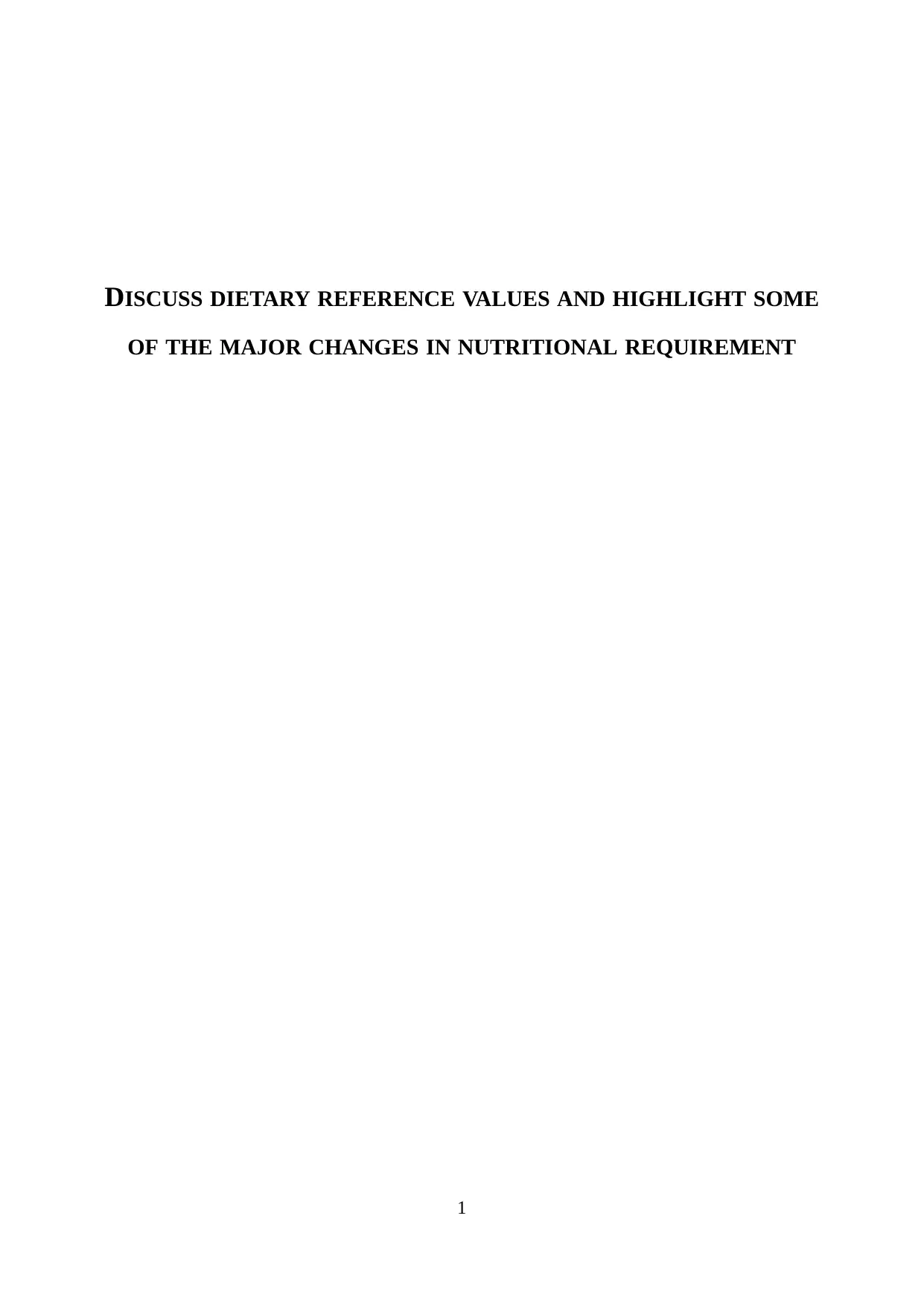
DISCUSS DIETARY REFERENCE VALUES AND HIGHLIGHT SOME
OF THE MAJOR CHANGES IN NUTRITIONAL REQUIREMENT
1
OF THE MAJOR CHANGES IN NUTRITIONAL REQUIREMENT
1
Paraphrase This Document
Need a fresh take? Get an instant paraphrase of this document with our AI Paraphraser
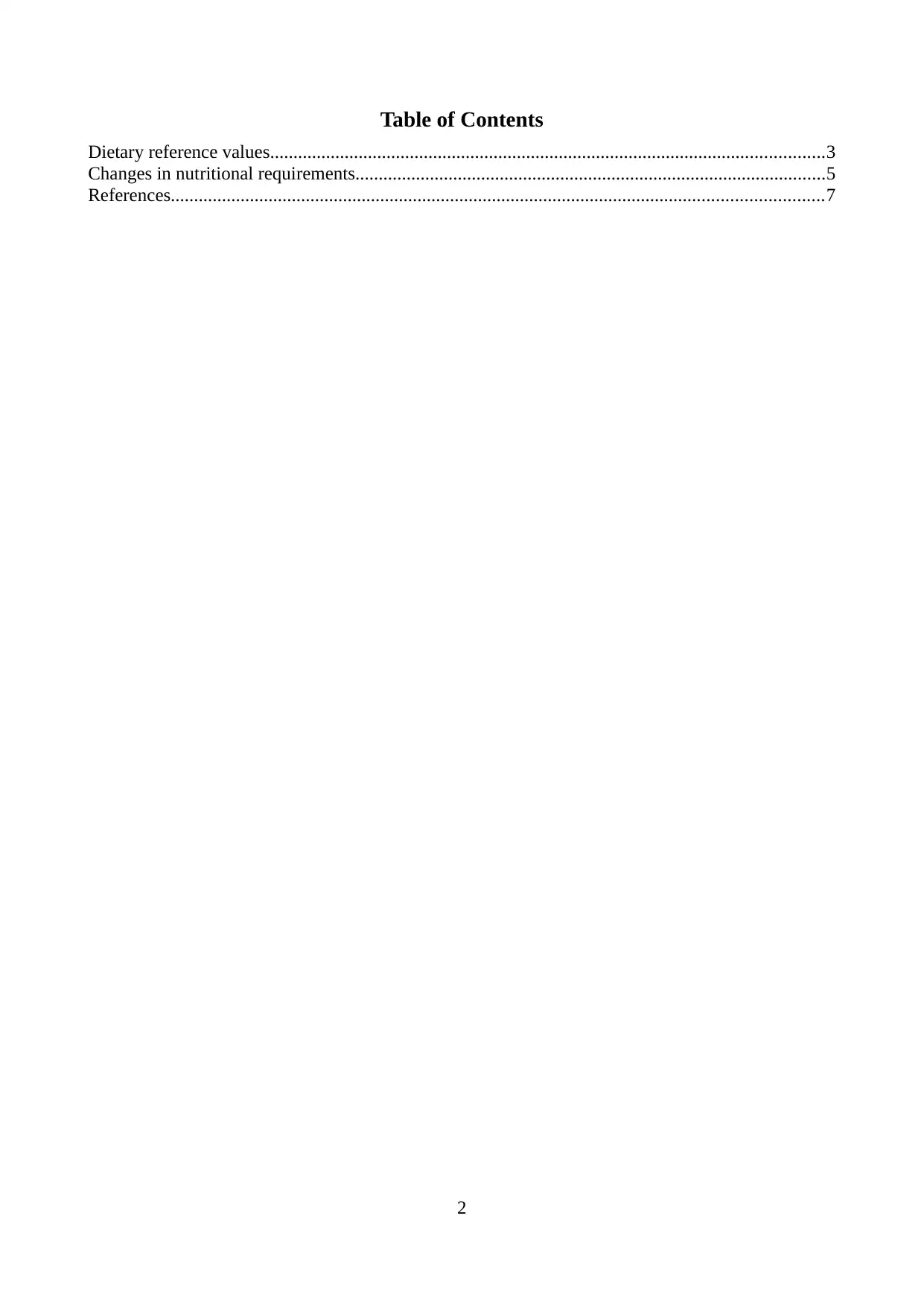
Table of Contents
Dietary reference values.......................................................................................................................3
Changes in nutritional requirements.....................................................................................................5
References............................................................................................................................................7
2
Dietary reference values.......................................................................................................................3
Changes in nutritional requirements.....................................................................................................5
References............................................................................................................................................7
2
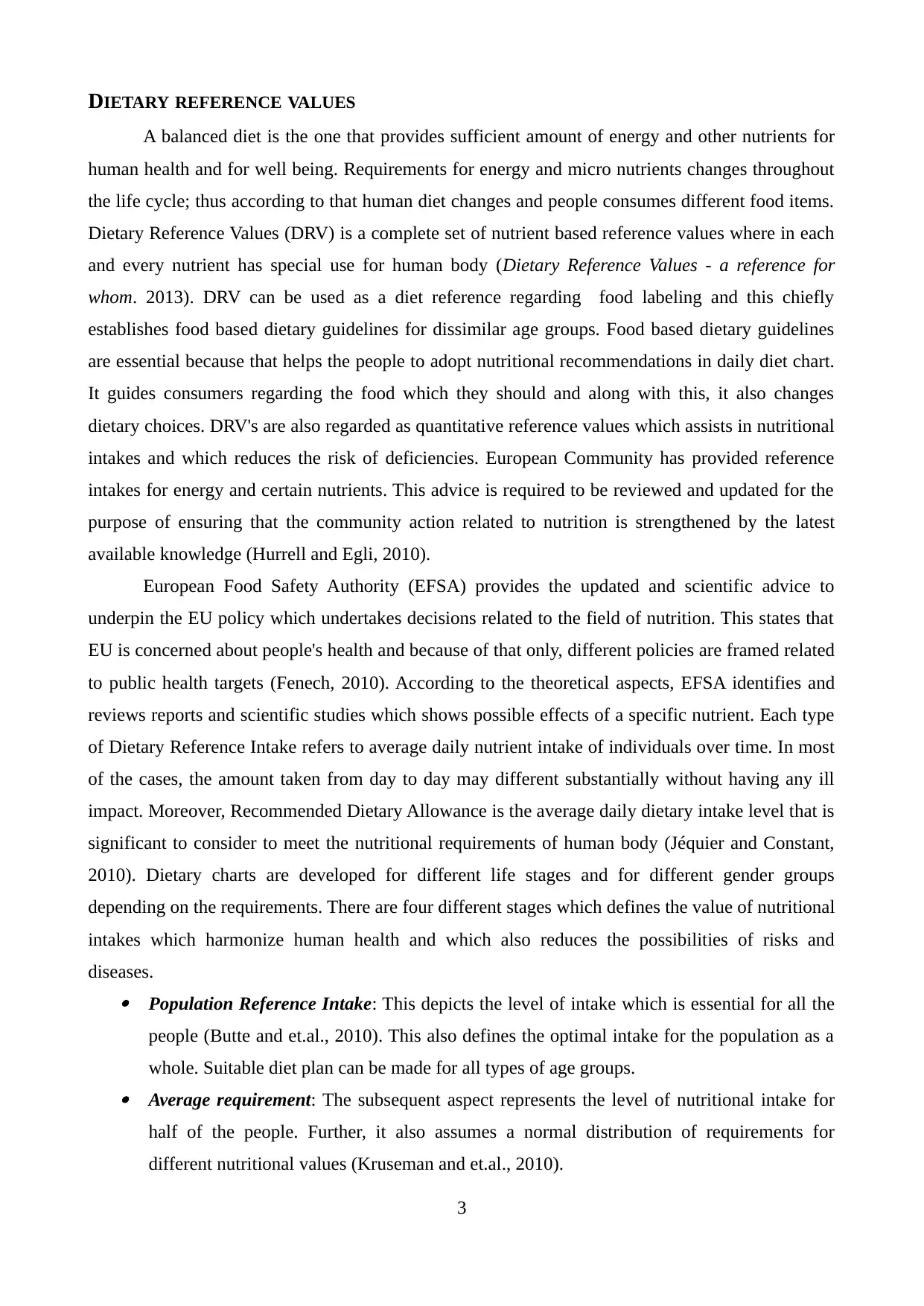
DIETARY REFERENCE VALUES
A balanced diet is the one that provides sufficient amount of energy and other nutrients for
human health and for well being. Requirements for energy and micro nutrients changes throughout
the life cycle; thus according to that human diet changes and people consumes different food items.
Dietary Reference Values (DRV) is a complete set of nutrient based reference values where in each
and every nutrient has special use for human body (Dietary Reference Values - a reference for
whom. 2013). DRV can be used as a diet reference regarding food labeling and this chiefly
establishes food based dietary guidelines for dissimilar age groups. Food based dietary guidelines
are essential because that helps the people to adopt nutritional recommendations in daily diet chart.
It guides consumers regarding the food which they should and along with this, it also changes
dietary choices. DRV's are also regarded as quantitative reference values which assists in nutritional
intakes and which reduces the risk of deficiencies. European Community has provided reference
intakes for energy and certain nutrients. This advice is required to be reviewed and updated for the
purpose of ensuring that the community action related to nutrition is strengthened by the latest
available knowledge (Hurrell and Egli, 2010).
European Food Safety Authority (EFSA) provides the updated and scientific advice to
underpin the EU policy which undertakes decisions related to the field of nutrition. This states that
EU is concerned about people's health and because of that only, different policies are framed related
to public health targets (Fenech, 2010). According to the theoretical aspects, EFSA identifies and
reviews reports and scientific studies which shows possible effects of a specific nutrient. Each type
of Dietary Reference Intake refers to average daily nutrient intake of individuals over time. In most
of the cases, the amount taken from day to day may different substantially without having any ill
impact. Moreover, Recommended Dietary Allowance is the average daily dietary intake level that is
significant to consider to meet the nutritional requirements of human body (Jéquier and Constant,
2010). Dietary charts are developed for different life stages and for different gender groups
depending on the requirements. There are four different stages which defines the value of nutritional
intakes which harmonize human health and which also reduces the possibilities of risks and
diseases. Population Reference Intake: This depicts the level of intake which is essential for all the
people (Butte and et.al., 2010). This also defines the optimal intake for the population as a
whole. Suitable diet plan can be made for all types of age groups. Average requirement: The subsequent aspect represents the level of nutritional intake for
half of the people. Further, it also assumes a normal distribution of requirements for
different nutritional values (Kruseman and et.al., 2010).
3
A balanced diet is the one that provides sufficient amount of energy and other nutrients for
human health and for well being. Requirements for energy and micro nutrients changes throughout
the life cycle; thus according to that human diet changes and people consumes different food items.
Dietary Reference Values (DRV) is a complete set of nutrient based reference values where in each
and every nutrient has special use for human body (Dietary Reference Values - a reference for
whom. 2013). DRV can be used as a diet reference regarding food labeling and this chiefly
establishes food based dietary guidelines for dissimilar age groups. Food based dietary guidelines
are essential because that helps the people to adopt nutritional recommendations in daily diet chart.
It guides consumers regarding the food which they should and along with this, it also changes
dietary choices. DRV's are also regarded as quantitative reference values which assists in nutritional
intakes and which reduces the risk of deficiencies. European Community has provided reference
intakes for energy and certain nutrients. This advice is required to be reviewed and updated for the
purpose of ensuring that the community action related to nutrition is strengthened by the latest
available knowledge (Hurrell and Egli, 2010).
European Food Safety Authority (EFSA) provides the updated and scientific advice to
underpin the EU policy which undertakes decisions related to the field of nutrition. This states that
EU is concerned about people's health and because of that only, different policies are framed related
to public health targets (Fenech, 2010). According to the theoretical aspects, EFSA identifies and
reviews reports and scientific studies which shows possible effects of a specific nutrient. Each type
of Dietary Reference Intake refers to average daily nutrient intake of individuals over time. In most
of the cases, the amount taken from day to day may different substantially without having any ill
impact. Moreover, Recommended Dietary Allowance is the average daily dietary intake level that is
significant to consider to meet the nutritional requirements of human body (Jéquier and Constant,
2010). Dietary charts are developed for different life stages and for different gender groups
depending on the requirements. There are four different stages which defines the value of nutritional
intakes which harmonize human health and which also reduces the possibilities of risks and
diseases. Population Reference Intake: This depicts the level of intake which is essential for all the
people (Butte and et.al., 2010). This also defines the optimal intake for the population as a
whole. Suitable diet plan can be made for all types of age groups. Average requirement: The subsequent aspect represents the level of nutritional intake for
half of the people. Further, it also assumes a normal distribution of requirements for
different nutritional values (Kruseman and et.al., 2010).
3
⊘ This is a preview!⊘
Do you want full access?
Subscribe today to unlock all pages.

Trusted by 1+ million students worldwide
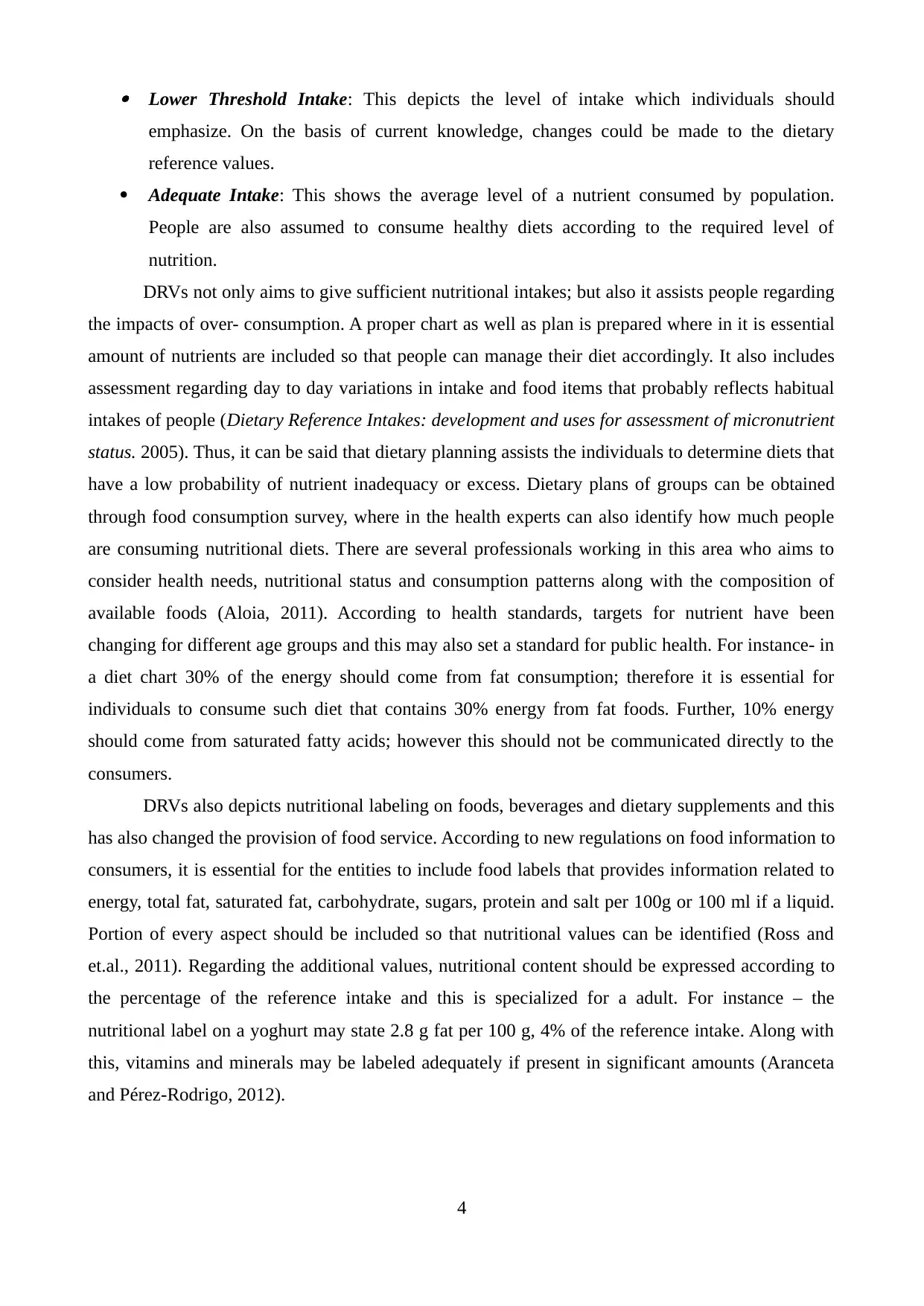
Lower Threshold Intake: This depicts the level of intake which individuals should
emphasize. On the basis of current knowledge, changes could be made to the dietary
reference values.
Adequate Intake: This shows the average level of a nutrient consumed by population.
People are also assumed to consume healthy diets according to the required level of
nutrition.
DRVs not only aims to give sufficient nutritional intakes; but also it assists people regarding
the impacts of over- consumption. A proper chart as well as plan is prepared where in it is essential
amount of nutrients are included so that people can manage their diet accordingly. It also includes
assessment regarding day to day variations in intake and food items that probably reflects habitual
intakes of people (Dietary Reference Intakes: development and uses for assessment of micronutrient
status. 2005). Thus, it can be said that dietary planning assists the individuals to determine diets that
have a low probability of nutrient inadequacy or excess. Dietary plans of groups can be obtained
through food consumption survey, where in the health experts can also identify how much people
are consuming nutritional diets. There are several professionals working in this area who aims to
consider health needs, nutritional status and consumption patterns along with the composition of
available foods (Aloia, 2011). According to health standards, targets for nutrient have been
changing for different age groups and this may also set a standard for public health. For instance- in
a diet chart 30% of the energy should come from fat consumption; therefore it is essential for
individuals to consume such diet that contains 30% energy from fat foods. Further, 10% energy
should come from saturated fatty acids; however this should not be communicated directly to the
consumers.
DRVs also depicts nutritional labeling on foods, beverages and dietary supplements and this
has also changed the provision of food service. According to new regulations on food information to
consumers, it is essential for the entities to include food labels that provides information related to
energy, total fat, saturated fat, carbohydrate, sugars, protein and salt per 100g or 100 ml if a liquid.
Portion of every aspect should be included so that nutritional values can be identified (Ross and
et.al., 2011). Regarding the additional values, nutritional content should be expressed according to
the percentage of the reference intake and this is specialized for a adult. For instance – the
nutritional label on a yoghurt may state 2.8 g fat per 100 g, 4% of the reference intake. Along with
this, vitamins and minerals may be labeled adequately if present in significant amounts (Aranceta
and Pérez-Rodrigo, 2012).
4
emphasize. On the basis of current knowledge, changes could be made to the dietary
reference values.
Adequate Intake: This shows the average level of a nutrient consumed by population.
People are also assumed to consume healthy diets according to the required level of
nutrition.
DRVs not only aims to give sufficient nutritional intakes; but also it assists people regarding
the impacts of over- consumption. A proper chart as well as plan is prepared where in it is essential
amount of nutrients are included so that people can manage their diet accordingly. It also includes
assessment regarding day to day variations in intake and food items that probably reflects habitual
intakes of people (Dietary Reference Intakes: development and uses for assessment of micronutrient
status. 2005). Thus, it can be said that dietary planning assists the individuals to determine diets that
have a low probability of nutrient inadequacy or excess. Dietary plans of groups can be obtained
through food consumption survey, where in the health experts can also identify how much people
are consuming nutritional diets. There are several professionals working in this area who aims to
consider health needs, nutritional status and consumption patterns along with the composition of
available foods (Aloia, 2011). According to health standards, targets for nutrient have been
changing for different age groups and this may also set a standard for public health. For instance- in
a diet chart 30% of the energy should come from fat consumption; therefore it is essential for
individuals to consume such diet that contains 30% energy from fat foods. Further, 10% energy
should come from saturated fatty acids; however this should not be communicated directly to the
consumers.
DRVs also depicts nutritional labeling on foods, beverages and dietary supplements and this
has also changed the provision of food service. According to new regulations on food information to
consumers, it is essential for the entities to include food labels that provides information related to
energy, total fat, saturated fat, carbohydrate, sugars, protein and salt per 100g or 100 ml if a liquid.
Portion of every aspect should be included so that nutritional values can be identified (Ross and
et.al., 2011). Regarding the additional values, nutritional content should be expressed according to
the percentage of the reference intake and this is specialized for a adult. For instance – the
nutritional label on a yoghurt may state 2.8 g fat per 100 g, 4% of the reference intake. Along with
this, vitamins and minerals may be labeled adequately if present in significant amounts (Aranceta
and Pérez-Rodrigo, 2012).
4
Paraphrase This Document
Need a fresh take? Get an instant paraphrase of this document with our AI Paraphraser
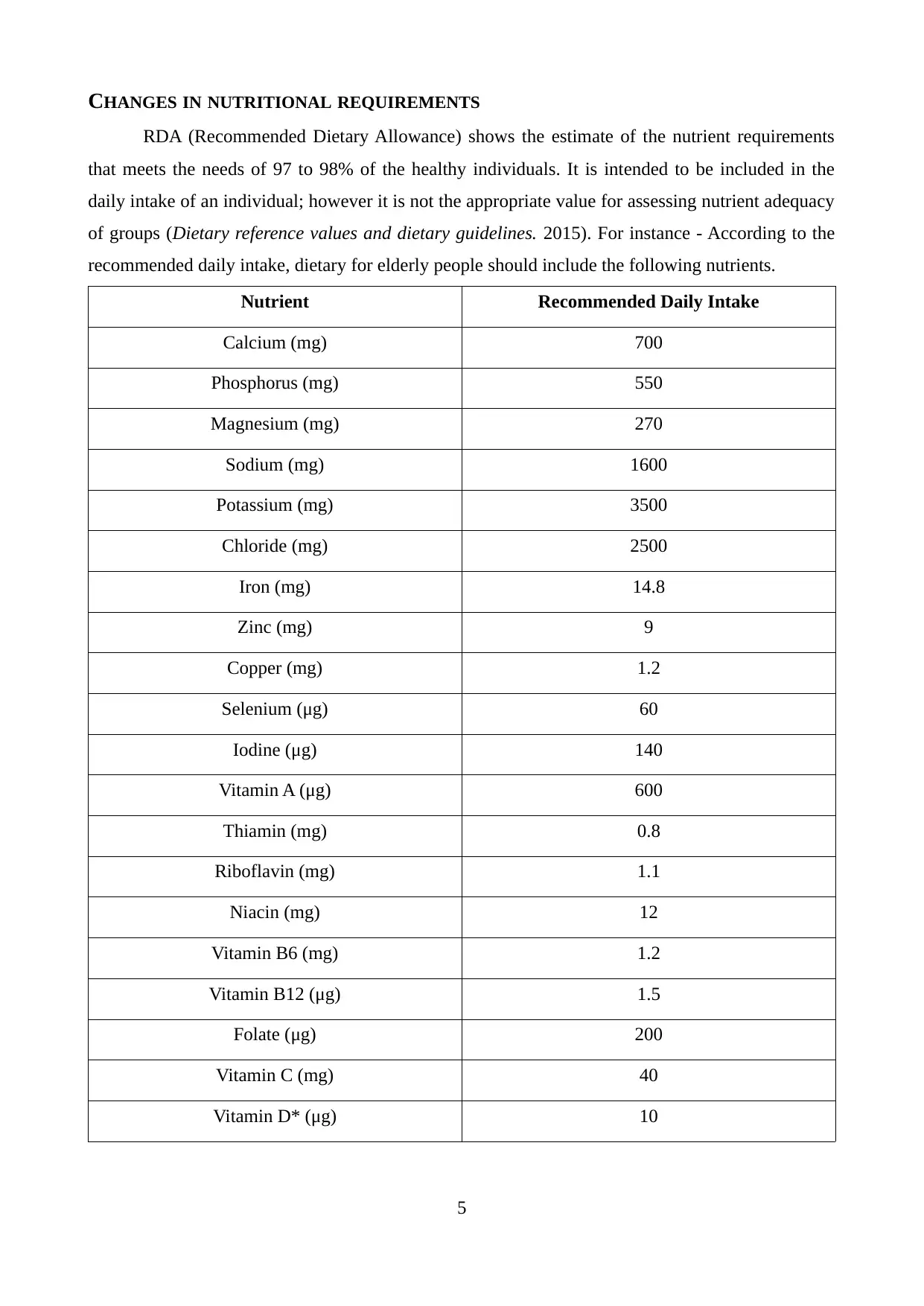
CHANGES IN NUTRITIONAL REQUIREMENTS
RDA (Recommended Dietary Allowance) shows the estimate of the nutrient requirements
that meets the needs of 97 to 98% of the healthy individuals. It is intended to be included in the
daily intake of an individual; however it is not the appropriate value for assessing nutrient adequacy
of groups (Dietary reference values and dietary guidelines. 2015). For instance - According to the
recommended daily intake, dietary for elderly people should include the following nutrients.
Nutrient Recommended Daily Intake
Calcium (mg) 700
Phosphorus (mg) 550
Magnesium (mg) 270
Sodium (mg) 1600
Potassium (mg) 3500
Chloride (mg) 2500
Iron (mg) 14.8
Zinc (mg) 9
Copper (mg) 1.2
Selenium (μg) 60
Iodine (μg) 140
Vitamin A (μg) 600
Thiamin (mg) 0.8
Riboflavin (mg) 1.1
Niacin (mg) 12
Vitamin B6 (mg) 1.2
Vitamin B12 (μg) 1.5
Folate (μg) 200
Vitamin C (mg) 40
Vitamin D* (μg) 10
5
RDA (Recommended Dietary Allowance) shows the estimate of the nutrient requirements
that meets the needs of 97 to 98% of the healthy individuals. It is intended to be included in the
daily intake of an individual; however it is not the appropriate value for assessing nutrient adequacy
of groups (Dietary reference values and dietary guidelines. 2015). For instance - According to the
recommended daily intake, dietary for elderly people should include the following nutrients.
Nutrient Recommended Daily Intake
Calcium (mg) 700
Phosphorus (mg) 550
Magnesium (mg) 270
Sodium (mg) 1600
Potassium (mg) 3500
Chloride (mg) 2500
Iron (mg) 14.8
Zinc (mg) 9
Copper (mg) 1.2
Selenium (μg) 60
Iodine (μg) 140
Vitamin A (μg) 600
Thiamin (mg) 0.8
Riboflavin (mg) 1.1
Niacin (mg) 12
Vitamin B6 (mg) 1.2
Vitamin B12 (μg) 1.5
Folate (μg) 200
Vitamin C (mg) 40
Vitamin D* (μg) 10
5
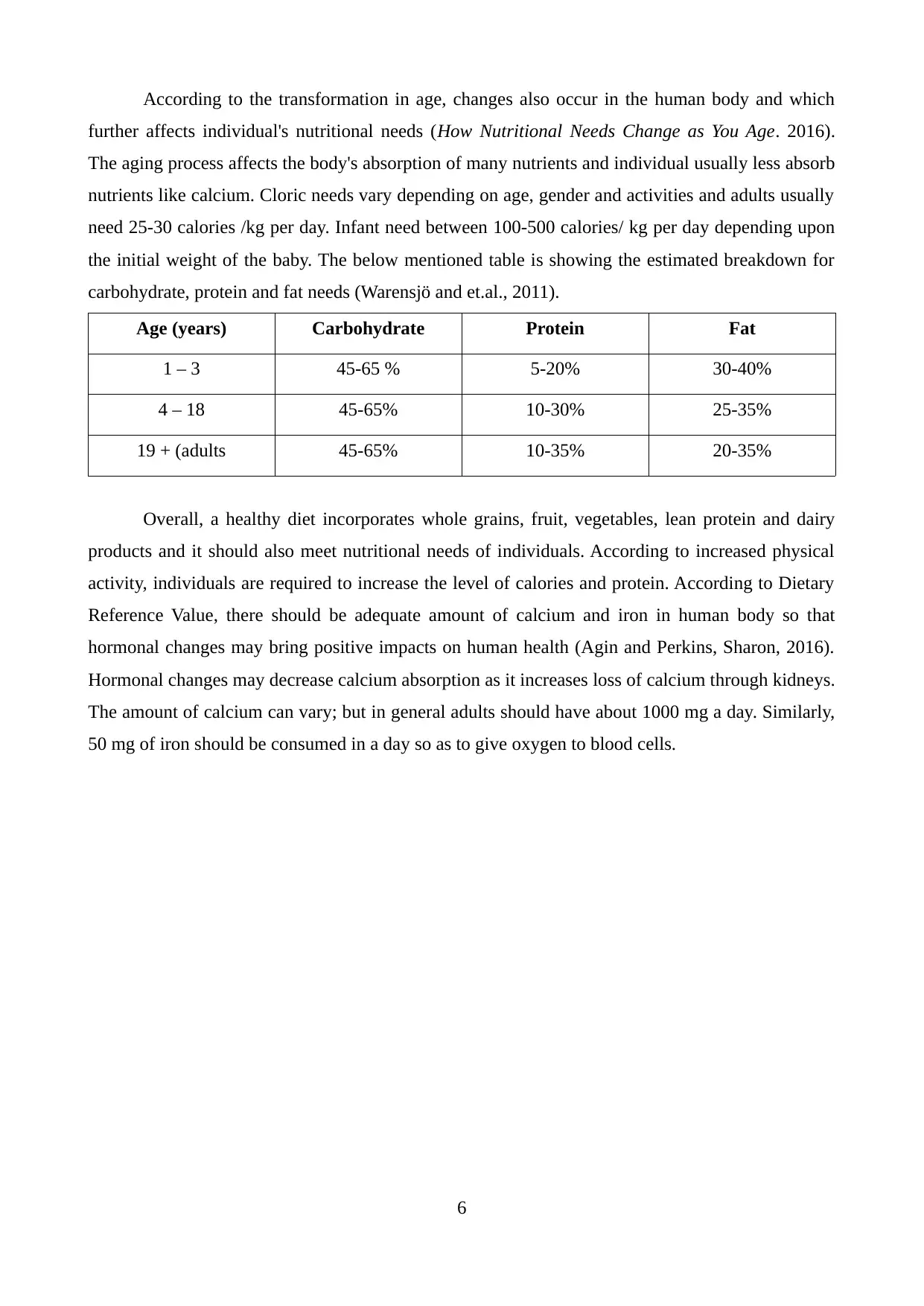
According to the transformation in age, changes also occur in the human body and which
further affects individual's nutritional needs (How Nutritional Needs Change as You Age. 2016).
The aging process affects the body's absorption of many nutrients and individual usually less absorb
nutrients like calcium. Cloric needs vary depending on age, gender and activities and adults usually
need 25-30 calories /kg per day. Infant need between 100-500 calories/ kg per day depending upon
the initial weight of the baby. The below mentioned table is showing the estimated breakdown for
carbohydrate, protein and fat needs (Warensjö and et.al., 2011).
Age (years) Carbohydrate Protein Fat
1 – 3 45-65 % 5-20% 30-40%
4 – 18 45-65% 10-30% 25-35%
19 + (adults 45-65% 10-35% 20-35%
Overall, a healthy diet incorporates whole grains, fruit, vegetables, lean protein and dairy
products and it should also meet nutritional needs of individuals. According to increased physical
activity, individuals are required to increase the level of calories and protein. According to Dietary
Reference Value, there should be adequate amount of calcium and iron in human body so that
hormonal changes may bring positive impacts on human health (Agin and Perkins, Sharon, 2016).
Hormonal changes may decrease calcium absorption as it increases loss of calcium through kidneys.
The amount of calcium can vary; but in general adults should have about 1000 mg a day. Similarly,
50 mg of iron should be consumed in a day so as to give oxygen to blood cells.
6
further affects individual's nutritional needs (How Nutritional Needs Change as You Age. 2016).
The aging process affects the body's absorption of many nutrients and individual usually less absorb
nutrients like calcium. Cloric needs vary depending on age, gender and activities and adults usually
need 25-30 calories /kg per day. Infant need between 100-500 calories/ kg per day depending upon
the initial weight of the baby. The below mentioned table is showing the estimated breakdown for
carbohydrate, protein and fat needs (Warensjö and et.al., 2011).
Age (years) Carbohydrate Protein Fat
1 – 3 45-65 % 5-20% 30-40%
4 – 18 45-65% 10-30% 25-35%
19 + (adults 45-65% 10-35% 20-35%
Overall, a healthy diet incorporates whole grains, fruit, vegetables, lean protein and dairy
products and it should also meet nutritional needs of individuals. According to increased physical
activity, individuals are required to increase the level of calories and protein. According to Dietary
Reference Value, there should be adequate amount of calcium and iron in human body so that
hormonal changes may bring positive impacts on human health (Agin and Perkins, Sharon, 2016).
Hormonal changes may decrease calcium absorption as it increases loss of calcium through kidneys.
The amount of calcium can vary; but in general adults should have about 1000 mg a day. Similarly,
50 mg of iron should be consumed in a day so as to give oxygen to blood cells.
6
⊘ This is a preview!⊘
Do you want full access?
Subscribe today to unlock all pages.

Trusted by 1+ million students worldwide
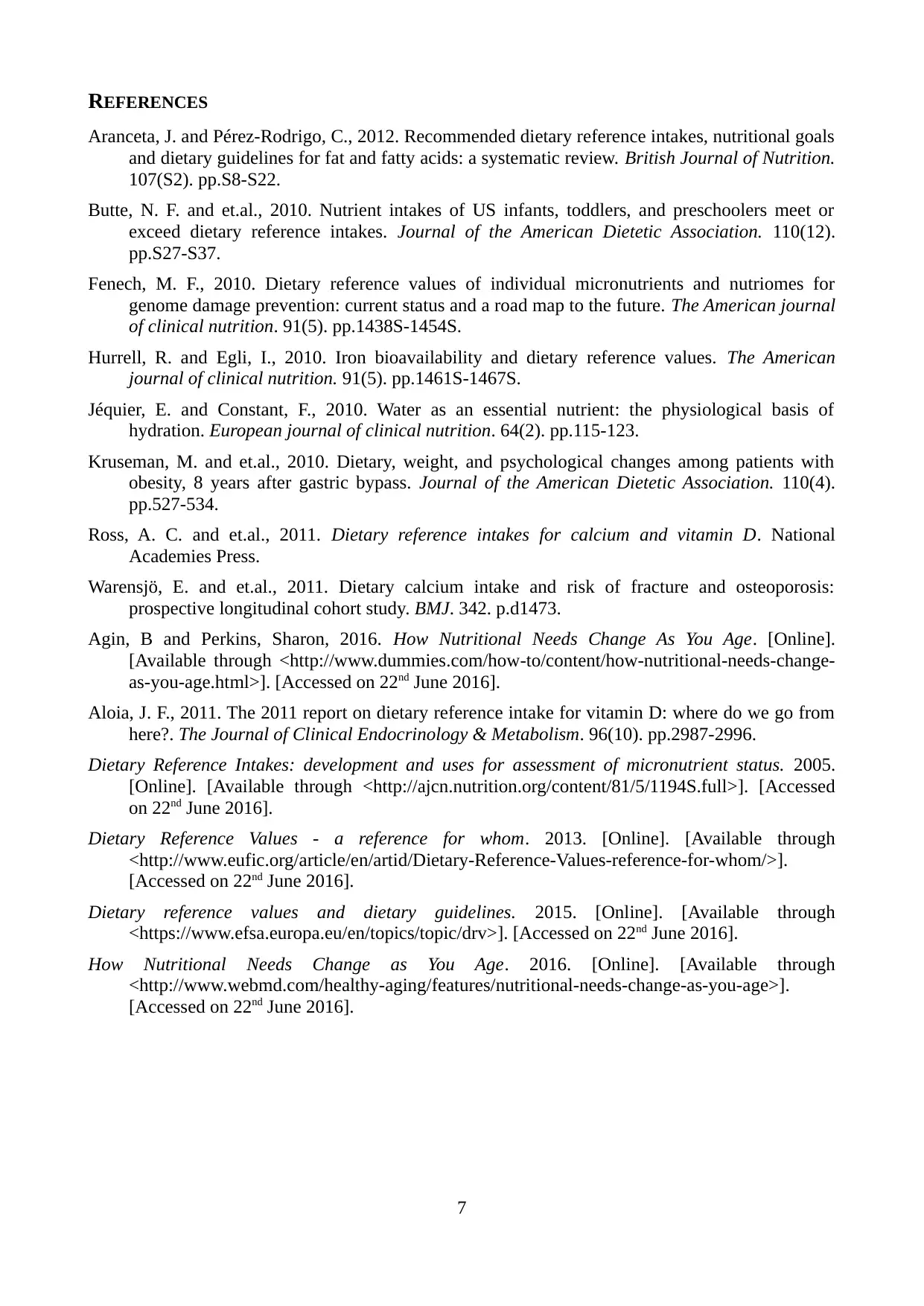
REFERENCES
Aranceta, J. and Pérez-Rodrigo, C., 2012. Recommended dietary reference intakes, nutritional goals
and dietary guidelines for fat and fatty acids: a systematic review. British Journal of Nutrition.
107(S2). pp.S8-S22.
Butte, N. F. and et.al., 2010. Nutrient intakes of US infants, toddlers, and preschoolers meet or
exceed dietary reference intakes. Journal of the American Dietetic Association. 110(12).
pp.S27-S37.
Fenech, M. F., 2010. Dietary reference values of individual micronutrients and nutriomes for
genome damage prevention: current status and a road map to the future. The American journal
of clinical nutrition. 91(5). pp.1438S-1454S.
Hurrell, R. and Egli, I., 2010. Iron bioavailability and dietary reference values. The American
journal of clinical nutrition. 91(5). pp.1461S-1467S.
Jéquier, E. and Constant, F., 2010. Water as an essential nutrient: the physiological basis of
hydration. European journal of clinical nutrition. 64(2). pp.115-123.
Kruseman, M. and et.al., 2010. Dietary, weight, and psychological changes among patients with
obesity, 8 years after gastric bypass. Journal of the American Dietetic Association. 110(4).
pp.527-534.
Ross, A. C. and et.al., 2011. Dietary reference intakes for calcium and vitamin D. National
Academies Press.
Warensjö, E. and et.al., 2011. Dietary calcium intake and risk of fracture and osteoporosis:
prospective longitudinal cohort study. BMJ. 342. p.d1473.
Agin, B and Perkins, Sharon, 2016. How Nutritional Needs Change As You Age. [Online].
[Available through <http://www.dummies.com/how-to/content/how-nutritional-needs-change-
as-you-age.html>]. [Accessed on 22nd June 2016].
Aloia, J. F., 2011. The 2011 report on dietary reference intake for vitamin D: where do we go from
here?. The Journal of Clinical Endocrinology & Metabolism. 96(10). pp.2987-2996.
Dietary Reference Intakes: development and uses for assessment of micronutrient status. 2005.
[Online]. [Available through <http://ajcn.nutrition.org/content/81/5/1194S.full>]. [Accessed
on 22nd June 2016].
Dietary Reference Values - a reference for whom. 2013. [Online]. [Available through
<http://www.eufic.org/article/en/artid/Dietary-Reference-Values-reference-for-whom/>].
[Accessed on 22nd June 2016].
Dietary reference values and dietary guidelines. 2015. [Online]. [Available through
<https://www.efsa.europa.eu/en/topics/topic/drv>]. [Accessed on 22nd June 2016].
How Nutritional Needs Change as You Age. 2016. [Online]. [Available through
<http://www.webmd.com/healthy-aging/features/nutritional-needs-change-as-you-age>].
[Accessed on 22nd June 2016].
7
Aranceta, J. and Pérez-Rodrigo, C., 2012. Recommended dietary reference intakes, nutritional goals
and dietary guidelines for fat and fatty acids: a systematic review. British Journal of Nutrition.
107(S2). pp.S8-S22.
Butte, N. F. and et.al., 2010. Nutrient intakes of US infants, toddlers, and preschoolers meet or
exceed dietary reference intakes. Journal of the American Dietetic Association. 110(12).
pp.S27-S37.
Fenech, M. F., 2010. Dietary reference values of individual micronutrients and nutriomes for
genome damage prevention: current status and a road map to the future. The American journal
of clinical nutrition. 91(5). pp.1438S-1454S.
Hurrell, R. and Egli, I., 2010. Iron bioavailability and dietary reference values. The American
journal of clinical nutrition. 91(5). pp.1461S-1467S.
Jéquier, E. and Constant, F., 2010. Water as an essential nutrient: the physiological basis of
hydration. European journal of clinical nutrition. 64(2). pp.115-123.
Kruseman, M. and et.al., 2010. Dietary, weight, and psychological changes among patients with
obesity, 8 years after gastric bypass. Journal of the American Dietetic Association. 110(4).
pp.527-534.
Ross, A. C. and et.al., 2011. Dietary reference intakes for calcium and vitamin D. National
Academies Press.
Warensjö, E. and et.al., 2011. Dietary calcium intake and risk of fracture and osteoporosis:
prospective longitudinal cohort study. BMJ. 342. p.d1473.
Agin, B and Perkins, Sharon, 2016. How Nutritional Needs Change As You Age. [Online].
[Available through <http://www.dummies.com/how-to/content/how-nutritional-needs-change-
as-you-age.html>]. [Accessed on 22nd June 2016].
Aloia, J. F., 2011. The 2011 report on dietary reference intake for vitamin D: where do we go from
here?. The Journal of Clinical Endocrinology & Metabolism. 96(10). pp.2987-2996.
Dietary Reference Intakes: development and uses for assessment of micronutrient status. 2005.
[Online]. [Available through <http://ajcn.nutrition.org/content/81/5/1194S.full>]. [Accessed
on 22nd June 2016].
Dietary Reference Values - a reference for whom. 2013. [Online]. [Available through
<http://www.eufic.org/article/en/artid/Dietary-Reference-Values-reference-for-whom/>].
[Accessed on 22nd June 2016].
Dietary reference values and dietary guidelines. 2015. [Online]. [Available through
<https://www.efsa.europa.eu/en/topics/topic/drv>]. [Accessed on 22nd June 2016].
How Nutritional Needs Change as You Age. 2016. [Online]. [Available through
<http://www.webmd.com/healthy-aging/features/nutritional-needs-change-as-you-age>].
[Accessed on 22nd June 2016].
7
1 out of 7
Related Documents
Your All-in-One AI-Powered Toolkit for Academic Success.
+13062052269
info@desklib.com
Available 24*7 on WhatsApp / Email
![[object Object]](/_next/static/media/star-bottom.7253800d.svg)
Unlock your academic potential
Copyright © 2020–2025 A2Z Services. All Rights Reserved. Developed and managed by ZUCOL.





